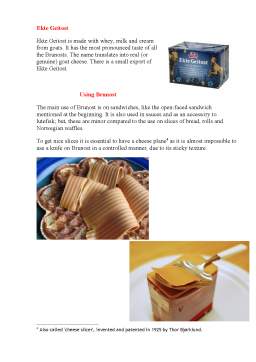Extras din referat
'Have some of this, it's good.' The Norwegian hands you an open-faced sandwich with a slice of something reddish-brown, 'It's Brunost - brown cheese.'
It doesn't look like cheese, you think, but you take a bite anyway.
'No way is this cheese!', you exclaim.
And you would be perfectly correct. Strictly speaking it isn't, but there are few things more Norwegian than an open-faced sandwich of Brunost.
Curds and Whey
General cheesemaking, all over the world, consists of separating the curds from the whey, and making some sort of cheese from the curds. The whey is then flushed down the drain or used as cattle feed. More recently, whey proteins have become popular as an ingredient in health food and dietary supplements for body-builders. However, in some parts of the world it has been considered good food for centuries. In Italy, for example, it is used to make ricotta, while in Norway it is used to make Brunost.
The upshot of this is that while 'real' cheeses are made only from the curds, ricotta, Brunost and similar, although often called cheeses, are technically whey-based dairy products.
History
For more than 300 years Norwegian farmers have made cheeses from cow's milk and goat's milk and turned the leftover whey into different kinds of foodstuffs. Many strange concoctions existed and some of these are still available, regionally, today.
The simplest process was to just boil out most of the water from the cow's whey, and shape the remainder into a sweet, low-fat, pale reddish brown 'cheese'. This is the most basic type of brown cheese and is simply called Mysost, or 'whey cheese'. By mixing in cream, or using goat's milk, or a combination of goat's and cow's milk, and/or by leaving more water in the mix, all of today's brown cheeses came into existence
Making Brunost
Brunost remains a very popular dairy product. Annual production is approximately 12 million kilograms, or almost 4kg per Norwegian. Of this amount, 50% is Gudbrandsdalsost, 30% is Fløtemysost, and 8 - 10% is Ekte Geitost. The remainder is made up of other varieties and small scale production sold straight from the farm.
The first step in the making of Brunost is removing the curds. The whey must not contain any remains of curds, rennet or lactic bacteria so today it is often pasteurised and centrifuged. Then milk and cream is added to the whey and it is boiled until it becomes a thick brown mass (in industrial production the initial dehydration is done by methods other than boiling). The brown colour appears at the end of the process when the mass reaches about 100°C. Several factors influence the colour, but a darker colour indicates a more pronounced taste, and a larger risk of it getting burned. The next step is to cool the mass quickly to about 80°C while stirring vigourously so the sugar forms small crystals with an even distribution.
Even though no preservatives are added, Brunost can be kept in the fridge for about four months, and up to a year at -8°C At lower temperatures the water freezes and ruins the 'cheese'.
A Norwegian Invention
How did brunost originate? In the summer of 1863, the milkmaid Anne Haav, who lived in Gudbrandsdalen Valley, tried an experiment that became a breakthrough. She made cheese from pure cow’s milk and thought of adding cream to the whey before boiling it down. The result was a tasty brown cheese, with full fat content. Later, people also started using goat’s milk and a mixture of goat’s milk and cow’s milk as a basis for the production. In 1933, at a ripe old age, Anne Haav was given the Norwegian king’s special medal of merit for her invention.
Preview document
Conținut arhivă zip
- Brunost - Norwegian Brown Cheese.doc













